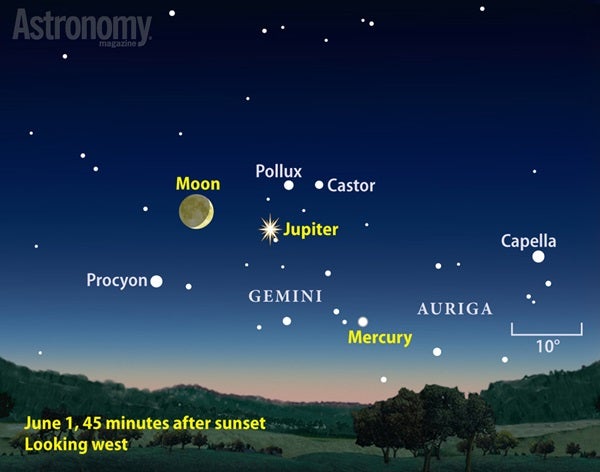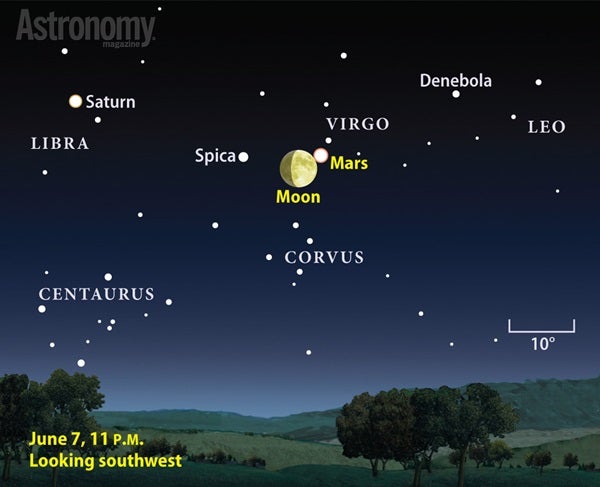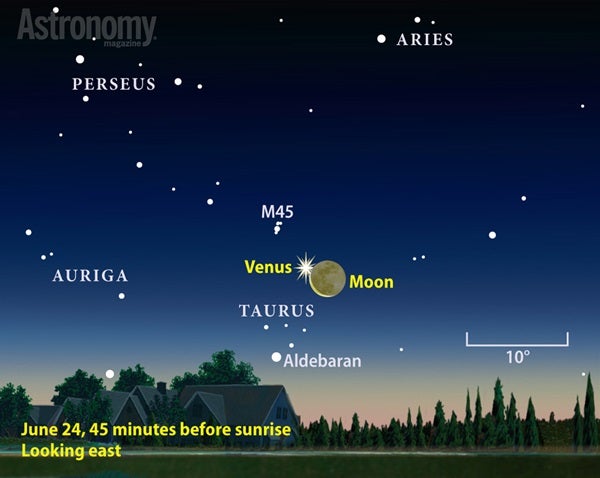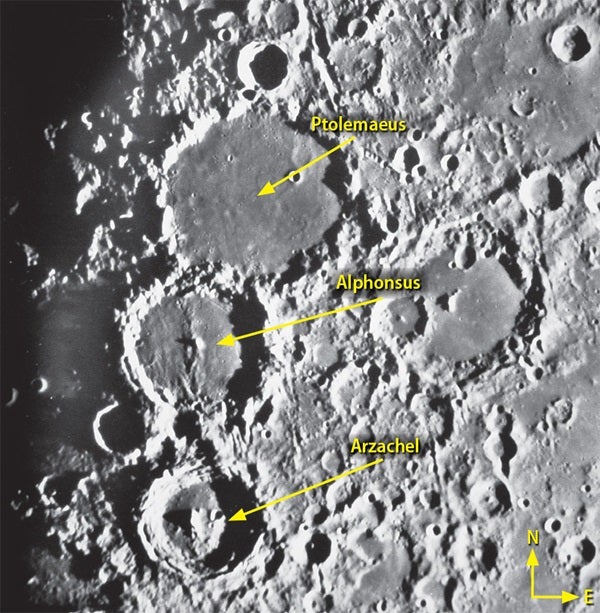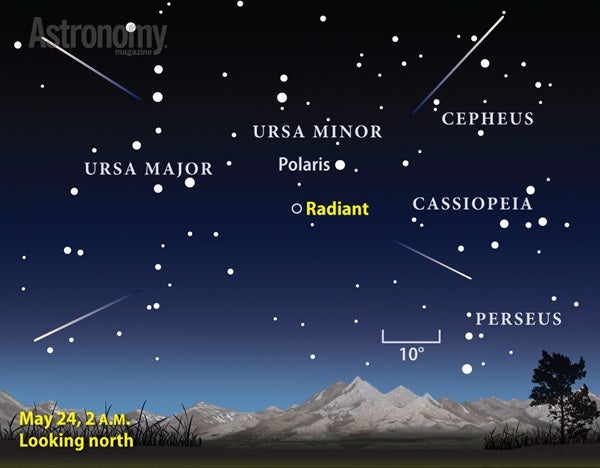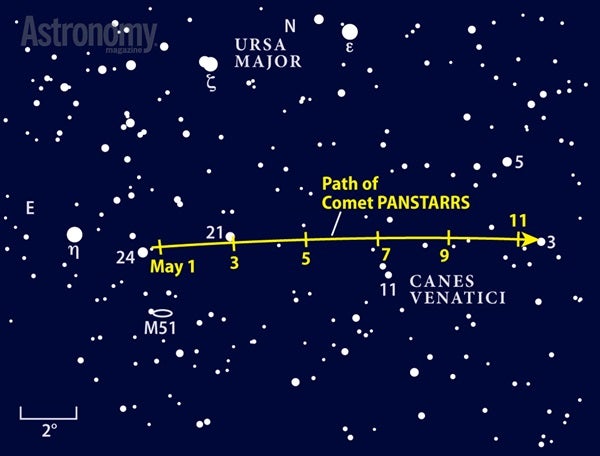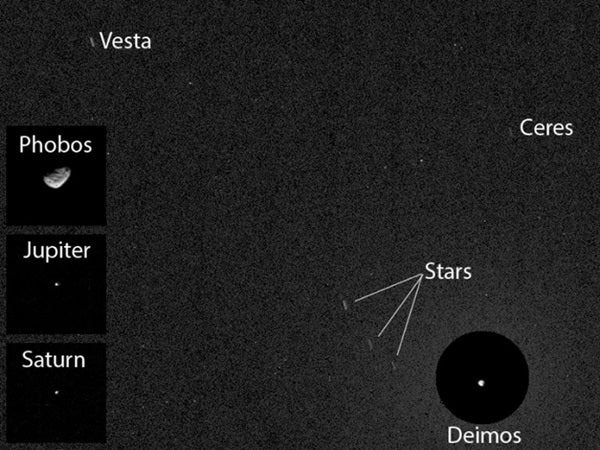The solar system’s two largest planets light up June’s evening sky: While Jupiter dips low in the west after sunset, Saturn rides high in the south. Smaller Mars also remains well-placed for evening viewing, though this is the last month when its disk spans more than 10″. Both Uranus and Neptune climb higher in the predawn darkness, but you’ll need binoculars to spot them. Nighttime viewing wraps up with brilliant Venus, which appears particularly stunning when a crescent Moon and the Pleiades star cluster join it in late June.
But before we get there, let’s turn our attention to the evening sky in early June. On the 1st, Mercury, Jupiter, and a 4-day-old crescent Moon hang gracefully in the west as darkness falls. At magnitude 1.2, Mercury appears quite dim in the twilight and sets about 90 minutes after the Sun. As the days pass, the innermost planet fades and becomes harder to see as it drops closer to the Sun. You’ll be hard-pressed to find it after June’s first week.
On June 1, Jupiter appears about 10° northwest (to the right) of the waxing Moon. Shining at magnitude –1.9, it stands out in the twilight within a half-hour of sunset. First-magnitude Pollux, the brightest star in Gemini the Twins, is significantly harder to see. It stands about one binocular field to the planet’s upper right.
The best time to view Jupiter through a telescope begins about 30 minutes after sundown and ends when the planet dips below 10° altitude (at which point its light has to pass through thick layers of turbulent air). That leaves about an hour to observe it in early June and only a half-hour by midmonth. Look for two dark atmospheric belts running parallel to each other, one on either side of the planet’s equator. Jupiter’s disk spans 33″ in early June.
The short viewing window for Jupiter this month limits your chances of catching its moons in intriguing configurations. Yet one event beckons observers with telescopes despite the time constraints. On June 3, Europa, Ganymede, and Callisto simultaneously cast their shadows on the jovian cloud tops. This rare triple shadow transit is the first since October 2013; the next will occur in January 2015, but the one after that won’t arrive until 2032.
The best views will come under dark skies in central and eastern Europe and parts of Africa. Although the event occurs in daylight from North America and western Europe, all observers who find Jupiter through their scopes will be able to see the shadows.
Callisto’s shadow starts the show when it touches Jupiter’s disk at 15h22m UT (11:22 a.m. EDT). The shadow of Europa follows at 17h08m UT (1:08 p.m. EDT), and Ganymede’s touches the jovian disk at 18h08m UT (2:08 p.m. EDT). The black dot cast by Ganymede appears largest while Europa’s is smallest (and will be hardest to see in daylight). The three shadows move in tandem across Jupiter’s disk for 95 minutes until Callisto’s lifts back into space at 19h43m UT (3:43 p.m. EDT).
The waxing crescent Moon tracks across the constellations Cancer, Leo, and Virgo during June’s first week, reaching a point 2° south of Mars on June 7. The pretty conjunction lasts just one day, but Mars remains a treat all month. On the 1st, the planet glows brightly at magnitude –0.5, some four times brighter than its 1st-magnitude neighbor, Spica. (Mars fades to magnitude 0.0 by month’s end.) The blue-white star is Virgo’s brightest, and it offers a lovely color contrast to the orange-red world. Neither object sets until well past midnight local daylight time.
Mars reached opposition and peak visibility in April, so the distance between it and Earth grows steadily this month. Still, the view through a 6-inch or larger telescope should be wonderful, particularly in early evening when it lies higher in the sky. The planet’s apparent size shrinks from 11.8″ to 9.5″ during the month, and the disk shows a distinct phase.
As darkness falls in North America on June 1, Sinus Sabaeus appears as a dark linear feature near the center of the martian disk while the broader Sinus Meridiani lies to its east. The planet’s most prominent dark feature — Syrtis Major — sits on the western limb (edge) and quickly rotates out of view.
If you observe at the same time each evening thereafter, Syrtis Major slides steadily closer to the disk’s center, reaching that point June 7. This apparent backward motion arises because Mars takes a little more than a half-hour longer to rotate on its axis than Earth does.
As darkness falls June 14, the dusky Mare Cimmerium appears south of the disk’s heart with the bright plains of Elysium to the north. By the evening of the 20th, these same features have “backed up” and appear near Mars’ eastern terminator — the dividing line between light and dark where the Sun is rising.
At the end of the month, the massive volcano Olympus Mons is about to rise at the eastern terminator during North American evening hours. You likely won’t see the mountain itself — it takes an exceptionally clear and steady sky and a 16-inch or larger instrument — but you might glimpse white mists near its position. These “orographic” clouds form as air rushes up the volcano’s flank and cools. The rest of the planet looks bright orange because desert plains then fill most of the Earth-facing hemisphere.
Saturn arrived at opposition in May and hardly appears worse for wear in June. When viewed through a telescope at midmonth, the ringed planet is an almost imperceptible 2 percent smaller than it was at its peak. And at magnitude 0.3, it shines nearly as bright. Saturn lies due south as night falls, surrounded by the much dimmer background stars of Libra the Balance.
When you first peer at Saturn through a telescope, the beautiful rings immediately grab your attention. They tilt 21° to our line of sight at midmonth with their northern side on display. The steep angle affords a fine view of the Cassini Division, a conspicuous dark gap that separates the outer A ring from the brighter B ring. The ring system’s long axis (east to west) spans 42″ and the short axis (north to south) 15″, slightly less than the 17″ polar diameter of the planet itself. Sharp-eyed observers might notice the disk’s equatorial diameter is 1.6″ broader.
After marveling at Saturn and its rings, try focusing on the planet’s family of moons. Eighth-magnitude Titan is the brightest and shows up through any telescope. It orbits the planet once every 16 days, passing due north of Saturn on June 1 and 17 and due south June 9 and 25.
Three 10th-magnitude moons — Tethys, Dione, and Rhea — lie within range of 4-inch scopes. And a 6-inch instrument should capture 12th-magnitude Enceladus, at least when this inner moon lies well clear of the rings’ glare. All four of these satellites orbit Saturn at a brisker pace than Titan, and you can see them change positions relative to one another within a few hours.
Distant Iapetus has to be one of the solar system’s strangest moons. It glows at 10th magnitude when it is far west of Saturn and its ice-covered hemisphere points earthward. But the moon dims to 12th magnitude as it reaches greatest eastern elongation and its dark side faces our way. Luckily for observers, it moves westward in June, passing 2.3′ due south of the planet June 12 before reaching 8.8′ west of Saturn on the 30th.
Distant Neptune rises around 1:30 a.m. local daylight time in early June and two hours earlier by month’s end. You’ll need binoculars or a telescope to pick up the faint glow of this magnitude 7.9 world. It lies against the starry backdrop of Aquarius the Water-bearer, about 2° northeast of 5th-magnitude Sigma (σ) Aquarii. Look for Neptune between two 7th-magnitude stars. A telescope reveals the planet’s blue-gray color and 2.3″-diameter disk.
Uranus rises about 90 minutes after Neptune and stands about 10° above the eastern horizon shortly before twilight begins. Glowing at magnitude 5.9, it’s an easy object through binoculars and even shows up to naked eyes from a dark observing site. It appears against the background of Pisces the Fish, between 2° and 3° south-southwest of 4th-magnitude Epsilon (ε) Piscium.
Don’t confuse Uranus with a pair of similarly bright stars (73 and 80 Psc) to its east. You can confirm a planet sighting by aiming your telescope at the object. Uranus shows a distinctive blue-green color and a disk that spans 3.5″.
The night sky saves one of its best for last. Venus rises at the first hint of twilight approximately two hours before the Sun throughout June. The planet shines brilliantly at magnitude –3.9 as it makes its way across Aries the Ram and then enters Taurus the Bull on June 18. Only the Moon lights up the night sky more than Venus.
You’ll have a chance to compare the two June 24 when the waning crescent Moon stands 2° to Venus’ right. As a bonus, the Pleiades star cluster (M45) hangs 6° above the planet. The trio will look stunning through binoculars, and the twilight scene has to rank as one of this summer’s treasures. A telescope reveals the stark difference between the Moon’s thin crescent and Venus’ gibbous phase. The planet’s disk appears 84 percent lit and 12″ in diameter on the 24th.
A TRIO OF THRILLING IMPACT SCARS
Three magnificent craters practically beg observers to explore the First Quarter Moon on the evening of June 5. Look along the terminator — the dividing line between sunlight and darkness on the lunar surface — and just south of the equator to find the northernmost and biggest of the three. Ptolemaeus spans 95 miles and sports a rugged rim that casts long shadows onto a relatively smooth floor.
Most large impact features have a complex set of central peaks, but Ptolemaeus doesn’t. Lunar scientists think the mountains exist but the impact that formed Mare Imbrium buried them under debris.
The smaller impact that excavated the 69-mile-wide crater Alphonsus to the south produced sharper features and a higher central peak.
The youngest of the three is Arzachel at the southern end. The rim and inner walls of this 60-mile-wide crater appear sharper than those of its northern neighbors, which were beaten down by impacts over many more millions of years.
To get a different sense of these three, return to them on subsequent nights. The higher Sun hints at their surface composition. Notice the handful of dark gray spots on Alphonsus’ floor. These are deposits of volcanic ash, sprayed out somewhat gently from their central cones. Spectra indicate that the composition of this ash is similar to the lava that welled up and created the large maria.
THE SLUGGISH METEORS OF BOÖTES
June ranks among the worst of times for meteor observers. The nights are the shortest of the year, which limits viewing time, and the month features no major showers. The main hope in 2014 is that the June Boötids put on a show.
This shower went dormant after a nice display in 1927, only to return in 1998. That year saw rates peak at 100 meteors per hour; six years later, another outburst produced about half this number. Although astronomers don’t expect the June Boötids to rekindle this year, the shower’s peak coincides with New Moon on June 27, so observing conditions couldn’t be better. These meteors hit Earth’s atmosphere at “only” 11 miles per second, the slowest of any shower.
| WHEN TO VIEW THE PLANETS |
||
| Evening Sky |
Midnight | Morning Sky |
| Mercury (northwest) |
Mars (southwest) |
Venus (east) |
| Mars (southwest) |
Saturn (southwest) |
Uranus (east) |
| Jupiter (west) |
Neptune (southeast) |
|
| Saturn (south) |
|
|
| |
||
A COMET TAKES AIM AT LEO’S HEAD
An 8th-magnitude comet certainly would spice up June’s evening sky, and it looks like there’s one on the way. Comet PANSTARRS (C/2012 K1) should glow about a magnitude brighter than the giant elliptical galaxies at the heart of the Virgo cluster, which lies some 40° to the comet’s southeast.
As June begins, PANSTARRS lies high in the evening sky among the background stars of Ursa Major the Great Bear. The comet appears 4° east of 3rd-magnitude Mu (μ) Ursae Majoris on the 1st, and the gap closes to 2° a few days later. Under a rural sky, a 4-inch telescope shows the 10th-magnitude galaxy NGC 3184 just west of Mu in the same low-power field. You’ll need to use averted vision (by looking off to the side) to pick out the diffuse round glow of the face-on spiral. Like the comet, it has a core that brightens to a dot.
But the two don’t look identical. PANSTARRS appears out-of-round because it is building two tails. The dust component spreads to the north along the comet’s orbit before fading gradually into the sky. Meanwhile, ionized gas gets blown straight east by the solar wind.
Good timing favors us this month. When the Moon’s light interferes with the view in mid-June, we don’t miss much because the comet is crossing a fairly boring chunk of sky in Leo Minor. When good viewing returns in the last 10 days of the month, the ancient ball of ice and dust floats above the sickle shape of Leo’s head.
If this comet had arrived six months earlier or later, it almost would have grazed Earth and dazzled us at magnitude –5. Instead, it will pass directly behind the Sun during August’s second week before returning to view this autumn.
SPACE ROCKS PASS WITHIN A STONE’S THROW
The two-for-one asteroid show continues in June. Dwarf planet 1 Ceres and its neighbor, asteroid 4 Vesta, lie about 10° north of 1st-magnitude Spica in Virgo. They appear high in the south as darkness settles in. From the suburbs, you can track Vesta through binoculars, though you’ll likely need a 3-inch scope to reliably see Ceres.
The two objects have faded since their April peaks, but Vesta still glows at 7th magnitude while Ceres is just one magnitude fainter. Fortunately, the sparse background of Virgo means they have no place to hide. The two arc slowly to the west of 3rd-magnitude Zeta (ζ) Virginis, which serves as a great guide for tracking purposes.
To see them at their closest, wait until late June, when they come within 23′ — less than the Full Moon’s diameter. You can see their movement from night to night as they pass through a triangle of background stars. To learn more about this close encounter, see “View Ceres and Vesta at their best” in the May issue.
Vesta reflects nearly five times as much light from its surface as Ceres does. The solution to this mystery should be solved in 2015 when NASA’s Dawn spacecraft enters orbit around Ceres.
Martin Ratcliffe provides planetarium development for Sky-Skan, Inc. from his home in Wichita, Kansas. Meteorologist Alister Ling works for Environment Canada in Edmonton, Alberta.

